How to Grow Starfruit: From Seedling to Harvest
- March 1, 2024
- 0 comment
Starfruit, also known as Carambola, is a unique tropical fruit known for its star-shaped cross-section and sweet-tart flavor. Originating in Southeast Asia, it has become popular in many parts of the world. This guide will take you through the steps to grow starfruit successfully in your garden or home.

Nutritional Benefits of Starfruit
| Benefit | Description |
|---|---|
| Rich in Nutrients | Starfruit is low in calories but packed with vitamin C, fiber, and smaller amounts of other essential nutrients. |
| Antioxidant Properties | Contains antioxidants like gallic acid and quercetin, which help combat oxidative stress and may boost overall health. |
| Supports Heart Health | The fiber, potassium, and other compounds in starfruit may contribute to cardiovascular health by reducing cholesterol levels and blood pressure. |
| Boosts Immune System | High vitamin C content strengthens the immune system, aiding in the prevention of various illnesses. |
| Digestive Health | The dietary fiber in starfruit helps improve digestion and prevent constipation. |
| Anti-Inflammatory Effects | Contains compounds that may have anti-inflammatory properties, potentially beneficial for reducing inflammation-related issues. |
| Skin Health | Vitamin C and antioxidants in starfruit can promote healthier skin by combating skin aging and improving skin texture. |
| Weight Management | Low in calories and high in fiber, making it a healthy snack option for weight control. |
List on How to Grow Starfruit
- Choosing the Right Variety
- Climate and Soil Requirements
- Planting
- Watering and Fertilization
- Pruning and Maintenance
- Harvesting
- Post-Harvest Care
Choosing the Right Variety
Starfruit comes in various types, ranging from sweet to tart flavors. Some popular varieties include ‘Arkin’, ‘Fwang Tung’, and ‘Sri Kembangan’. Choose a variety that suits your climate and taste preferences.
Arkin
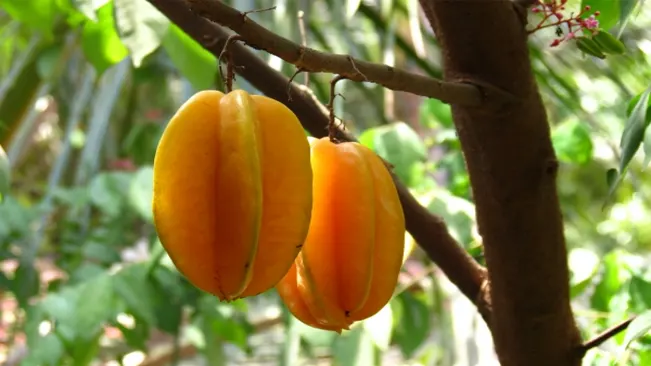
- Flavor: The Arkin variety is known for its sweet taste with minimal tartness, making it a favorite for fresh consumption.
- Fruit Characteristics: It typically produces large, uniform fruits with a bright yellow skin when ripe.
- Climate Suitability: Arkin starfruit does well in most tropical to subtropical regions and is somewhat more cold-tolerant than other varieties.
Fwang Tung
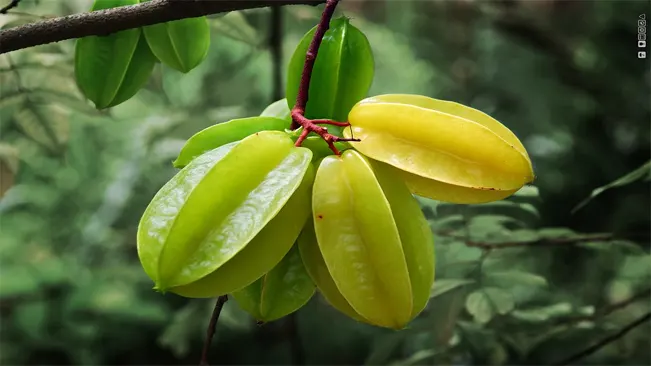
- Flavor: This variety is known for a balanced sweet-tart flavor, appealing to those who enjoy a slight tartness.
- Fruit Characteristics: Fwang Tung fruits are generally medium-sized with a slightly oblong shape.
- Climate Suitability: It thrives in warm, humid climates and may require more consistent warmth compared to the Arkin variety.
Sri Kembangan
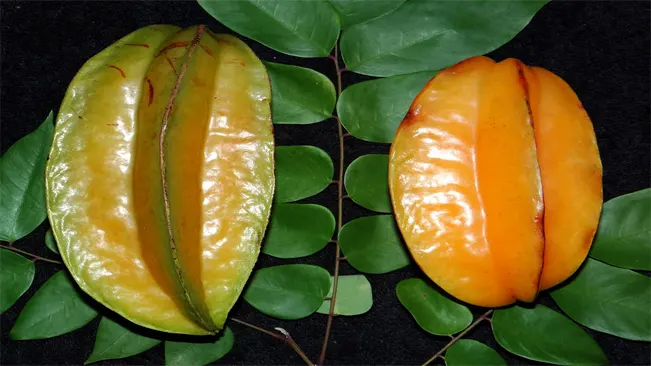
- Flavor: Sri Kembangan is noted for its exceptionally sweet taste, often preferred for desserts and juices.
- Fruit Characteristics: The fruits are typically large with a pronounced star shape, making them not only tasty but also visually appealing.
- Climate Suitability: It’s suited for tropical climates and can be more sensitive to cooler temperatures.
When selecting a variety, consider the following factors:
- Local Climate: Ensure the variety you choose is suited to your local weather conditions. Some varieties may be more tolerant of slight temperature variations.
- Purpose: If you intend to eat the fruit fresh, sweeter varieties like Arkin and Sri Kembangan are ideal. For culinary uses, a variety with a balance of sweet and tart, like Fwang Tung, may be more versatile.
- Space and Maintenance: Some varieties may grow larger and require more space or maintenance. Check the growth habits of the variety you’re considering.
Climate and Soil Requirements
Starfruit trees thrive in tropical to subtropical climates. They prefer temperatures between 68°F to 95°F (20°C to 35°C) and cannot withstand frost. The ideal soil for starfruit is well-draining and rich in organic matter with a pH of 5.5 to 6.5.
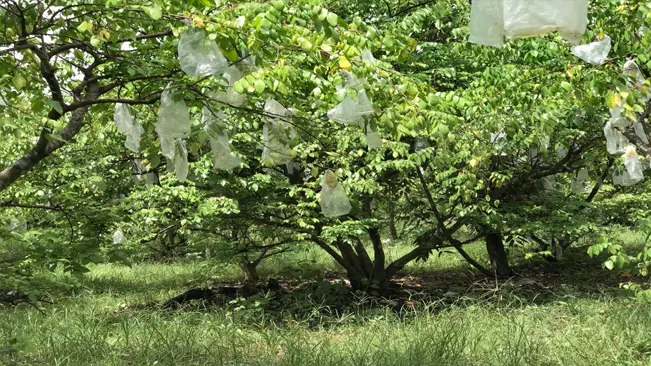
Climate Requirements
- Temperature Range: Starfruit trees are best suited to warm climates. They grow optimally in temperatures ranging from 68°F to 95°F (20°C to 35°C). This temperature range is crucial for their growth and fruit production.
- Frost Sensitivity: These trees are highly sensitive to cold and frost. Temperatures dropping below 32°F (0°C) can damage or even kill the tree. Therefore, they are not suitable for regions with cold winters unless grown in a controlled environment, like a greenhouse.
- Sunlight Needs: Starfruit trees need plenty of sunlight. A location that receives full sun, meaning direct sunlight for at least 6-8 hours a day, is ideal. This requirement makes them suitable for open spaces away from taller trees or buildings that cast shadows.
- Humidity: Being tropical plants, starfruit trees prefer high humidity. In dryer climates, additional watering or methods to increase humidity may be necessary.
Soil Requirements
- Well-Draining Soil: The soil needs to be well-draining to prevent waterlogging, which can lead to root rot. Starfruit trees are particularly sensitive to overwatering and standing water around their roots.
- Soil Richness: Fertile soil rich in organic matter is ideal for these trees. You can improve soil fertility by adding compost or well-rotted manure, which also helps with water retention and drainage.
- Soil pH: The preferred soil pH for starfruit trees is slightly acidic to neutral, ranging from 5.5 to 6.5. If your soil is not within this range, you can adjust the pH by adding lime (to raise the pH) or sulfur (to lower the pH).
- Mulching: Applying mulch around the base of the tree can help maintain soil moisture and temperature, as well as suppress weeds. However, keep the mulch a few inches away from the trunk to prevent moisture accumulation against the bark.
Planting
The best time to plant starfruit is in the spring or early summer. You can start with seeds or purchase a young tree from a nursery. Plant the tree in a sunny location, ensuring it has enough space to grow, as starfruit trees can reach 20 to 30 feet in height.
Choosing Between Seed or Sapling
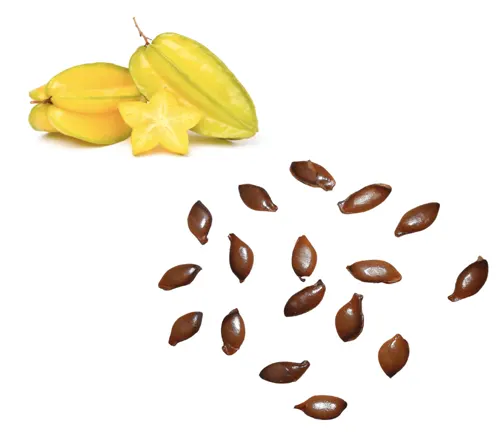
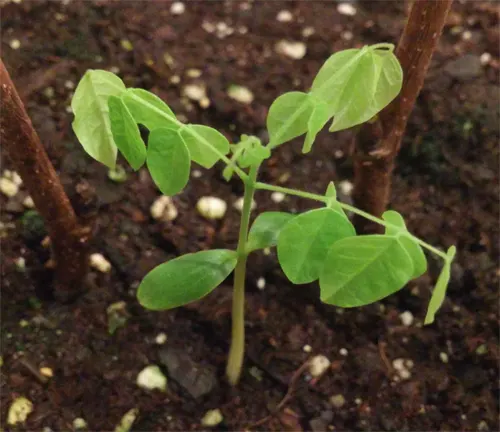
- Seed: Growing starfruit from seed can be a fun experiment, but it’s worth noting that seed-grown trees may not produce fruit identical to the parent tree. Germination can take anywhere from a few weeks to several months.
- Sapling: For more predictable results, many gardeners prefer to purchase a young tree from a nursery. These are typically grafted from mature, fruit-bearing trees, ensuring the quality and type of fruit they will produce.
Site Selection

- Sunlight: Starfruit trees need a lot of sunlight to thrive. Choose a location that receives full sun for most of the day.
- Space: These trees can grow quite large, so it’s important to plant them in an area where they’ll have enough room to expand. Ideally, they should be spaced 20 to 30 feet apart from other trees or structures.
Soil Preparation
- Soil Type: Starfruit prefers well-draining soil rich in organic matter. Heavy clay soils can be amended with compost or peat moss to improve drainage.
- pH Level: The ideal soil pH for starfruit is slightly acidic, between 5.5 and 6.5. You can test the soil pH using a home testing kit and adjust accordingly with soil amendments.
Planting Process
- Digging the Hole: The hole should be twice as wide and just as deep as the root ball of the sapling.
- Root Preparation: If the roots are bunched or circling, gently tease them apart before planting.
- Planting: Place the tree in the hole so that the top of the root ball is level with the ground surface. Backfill the hole with soil, tamping down gently to remove air pockets.
- Watering: After planting, water the tree thoroughly to settle the soil around the roots.
Post-Planting Care
- Mulching: Apply a layer of organic mulch around the base of the tree to retain moisture and suppress weeds.
- Initial Watering: Water the tree regularly, especially during the first few months as it establishes itself. The soil should be kept consistently moist but not waterlogged.
Protection
- Young Trees: Newly planted trees may need some protection from intense sun, wind, or frost. Consider using a shade cloth or windbreak if necessary.
Watering and Fertilization
Starfruit trees require regular watering, especially during dry periods. However, avoid over-watering as it can lead to root rot. Fertilize the tree every two to three months with a balanced fertilizer high in potassium and magnesium.
Watering
- Frequency and Amount: The key to watering starfruit trees is to maintain a balance. During the growing season, especially in dry periods, regular watering is essential. The frequency depends on your climate and soil type, but generally, watering once a week is sufficient. In very hot or windy weather, more frequent watering may be necessary.
- Soil Moisture Check: Before watering, check the soil moisture. The top inch of soil should be dry to the touch. If it’s still moist, you may delay watering. Over-watering can be as harmful as under-watering, leading to root rot and other issues.
- Watering Technique: When watering, do so deeply and slowly. This method encourages deeper root growth and ensures the water reaches the roots rather than just wetting the surface.
- Mulching: Applying mulch around the base of the tree can help retain soil moisture and reduce the frequency of watering. Be sure to leave some space around the trunk to prevent rot.
Fertilization
- Type of Fertilizer: Use a balanced fertilizer, ideally one that’s high in potassium and magnesium. These nutrients are crucial for the overall health of the tree and fruit production. Fertilizers labeled for citrus or tropical fruits usually work well for starfruit.
- Frequency of Application: Fertilize every two to three months. However, the frequency may vary depending on the age of the tree and the specific product’s instructions. Younger trees typically require more frequent fertilization.
- Method of Application: Apply the fertilizer around the drip line of the tree, which is the area directly below the outer circumference of the tree branches. Avoid placing fertilizer too close to the trunk as this can cause burn.
- Adjusting Fertilization: Observe your tree’s health and growth. Yellowing leaves or slow growth may indicate a need for more frequent fertilization or a different nutrient balance.
- Organic Options: If you prefer organic methods, consider using compost, well-rotted manure, or other organic fertilizers. These not only provide nutrients but also improve soil health.
Pruning and Maintenance
Prune the tree to remove dead or diseased branches and to maintain a manageable size. Regular pruning also encourages fruit production. Keep an eye out for pests like aphids and mealybugs and diseases like leaf spot.
Pruning
- Timing: The best time to prune your starfruit tree is late winter or early spring, just before the new growth starts. This timing helps the tree heal faster and reduces the risk of disease.
- Objectives:
- Remove Dead or Diseased Branches: This helps prevent the spread of diseases and pests.
- Shape the Tree: Pruning helps maintain a desired shape and size, making it easier to harvest the fruit.
- Encourage Fruit Production: By removing some of the older branches, you encourage the growth of new branches which are more likely to bear fruit.
- Techniques:
- Thinning: Remove some of the smaller, weaker branches entirely to allow light and air to penetrate the canopy.
- Heading Back: Trim back the ends of branches to encourage branching and denser growth.
- Selective Pruning: Remove only the branches that are necessary – over-pruning can stress the tree.
Maintenance
- Pest Control:
- Aphids and Mealybugs: These are common pests that can be controlled with insecticidal soaps or oils. Regularly inspect your tree for signs of these pests.
- Natural Predators: Encourage beneficial insects like ladybugs, which feed on aphids and mealybugs.
- Disease Prevention:
- Leaf Spot: This is a common fungal issue that can be minimized by ensuring good air circulation around the tree.
- Regular Inspection: Regularly check for signs of disease, such as discolored leaves or unusual spots, and treat them promptly.
- General Care:
- Mulching: Apply mulch around the base of the tree to retain moisture and suppress weeds.
- Watering: Water the tree deeply but infrequently, allowing the soil to dry out slightly between waterings.
- Fertilization: Fertilize the tree with a balanced fertilizer, especially during the growing season, to ensure it gets all the necessary nutrients.
Harvesting
Harvesting starfruit requires an understanding of its growth cycle. As you mentioned, starfruit typically matures in 10 to 12 months after flowering. The key to successful harvesting is recognizing the right time to pick the fruit.
Recognizing Ripe Starfruit
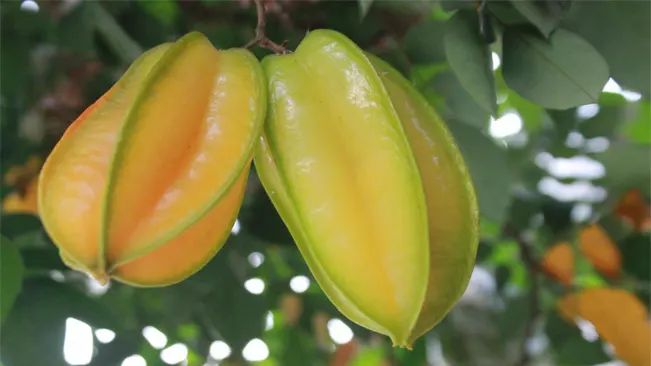
- Color Change: Ripe starfruit changes from green to a bright, vibrant yellow. Some varieties may have a hint of green remaining, but the predominant color should be yellow.
- Texture and Firmness: The fruit should feel firm but give slightly to gentle pressure. Overripe fruit may feel mushy, while underripe fruit is excessively hard.
- Fragrance: Ripe starfruit emits a sweet, slightly tangy aroma. A stronger, more noticeable fragrance indicates the fruit is ready to be picked.
Harvesting Technique
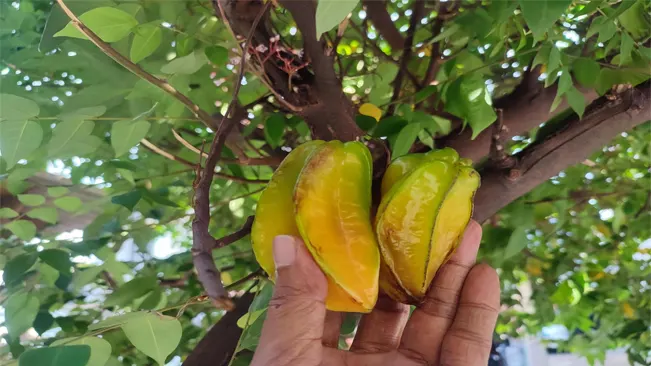
- Gentle Twisting: As you mentioned, gently twist the fruit off the branch to avoid damaging the tree. This method helps ensure the fruit is detached without harming the stem or nearby fruits.
- Using Pruners: For hard-to-reach fruits or those that do not twist off easily, use a pair of clean, sharp pruners or scissors to cut the fruit from the branch. Make sure to cut close to the fruit to avoid leaving a long stem, which can harm the tree and the remaining fruits.
Post-Harvest Care
After harvesting, proper care of starfruit is essential to maintain its quality and extend its shelf life. The post-harvest phase includes several key aspects:
Handling and Storage
- Delicate Handling: Starfruit is somewhat delicate and can bruise easily. Handle the fruit gently during and after harvest.
- Room Temperature Storage: If you plan to consume the starfruit within a few days, store it at room temperature. This helps the fruit to maintain its flavor and texture.
- Refrigeration: For longer storage, place starfruit in the refrigerator. This can extend its shelf life for up to 2 weeks. Store the fruit in a plastic bag or container to retain moisture.
Ripening
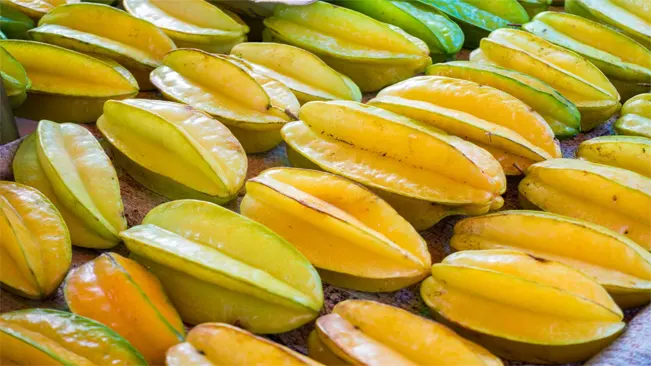
- Ripening Process: If harvested when they’re still a bit green, starfruit will continue to ripen at room temperature. The fruit becomes sweeter and more aromatic as it ripens.
- Visual and Texture Cues: A ripe starfruit is bright yellow with light brown edges, and it should yield slightly to pressure. Overripe starfruit will start to turn brown and become mushy.
Consumption and Usage
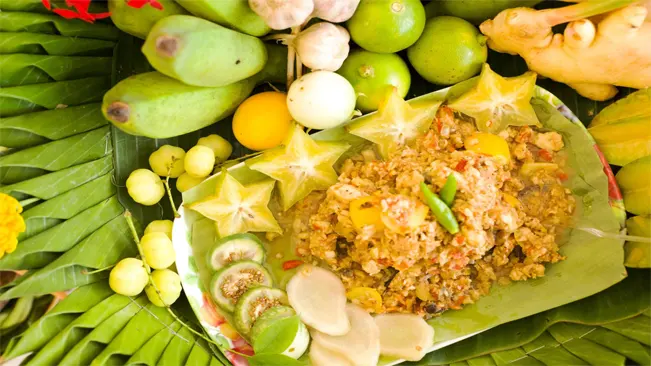
- Direct Consumption: Ripe starfruit can be eaten fresh. The entire fruit is edible, including the skin, but the seeds are usually discarded.
- Cooking and Juicing: Starfruit is versatile in cooking and can be used in salads, desserts, juices, and as a garnish. Its unique sweet-tart flavor complements many dishes.
- Preservation: You can also preserve starfruit by making jams, pickles, or dehydrating it for dried fruit snacks.
Health Considerations
- Kidney Health: People with kidney problems or those on certain medications should be cautious, as starfruit contains substances that can be harmful in these cases.
- Allergic Reactions: While rare, some individuals may have allergic reactions to starfruit. If you experience any adverse reactions, discontinue use and consult a doctor.
Nutritional Benefits
- Rich in Nutrients: Besides its delicious taste, starfruit is a good source of vitamin C, fiber, and antioxidants, making it a healthy addition to your diet.
Conclusion
Growing starfruit can be a rewarding experience, offering both ornamental beauty and delicious fruits. With proper care and attention, your starfruit tree will be a fruitful addition to your garden. Remember to check local regulations, as starfruit can be invasive in some regions.
FAQs (Frequently Asked Questions)
- What climate is best for growing starfruit?
Starfruit thrives in tropical to subtropical climates. It requires warm temperatures and cannot tolerate frost. - Can I grow starfruit from seed?
Yes, starfruit can be grown from seeds, but it’s often easier to start with a young tree from a nursery for better yield and fruit quality. - How much sun does a starfruit tree need?
Starfruit trees need full sun, meaning at least 6-8 hours of direct sunlight daily. - What type of soil is suitable for starfruit?
The ideal soil for starfruit is well-draining, rich in organic matter, and has a pH between 5.5 and 6.5. - How often should I water my starfruit tree?
Regular watering is important, especially during dry periods. However, avoid over-watering as it can lead to root rot. - When is the best time to plant a starfruit tree?
The best time to plant is in spring or early summer when the weather is warm. - How do I fertilize a starfruit tree?
Use a balanced fertilizer high in potassium and magnesium every two to three months. - When and how should I prune my starfruit tree?
Prune in late winter or early spring to remove dead or diseased branches and to shape the tree. Regular pruning also encourages fruiting. - How long does it take for a starfruit tree to bear fruit?
Starfruit trees typically start bearing fruit in 3-4 years after planting. - How do I know when starfruit is ripe and ready to harvest?
Ripe starfruit will be bright yellow with slightly brown ridges and should give slightly to gentle pressure. It’s typically ready to harvest about 10-12 months after flowering.

Kristine Moore
Forestry AuthorI'm Kristine Moore, a seasoned garden landscaping professional with over 30 years of experience. My extensive career has been dedicated to transforming outdoor spaces into stunning, sustainable landscapes. With a deep understanding of horticulture, design principles, and environmental stewardship, I have become a respected figure in the field, known for creating harmonious, visually appealing, and eco-friendly gardens. My commitment to excellence and continuous learning in landscaping trends and techniques has solidified my reputation as an expert in garden design and implementation.









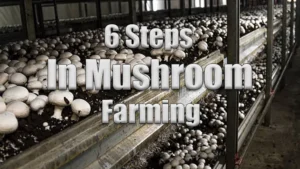



Leave your comment